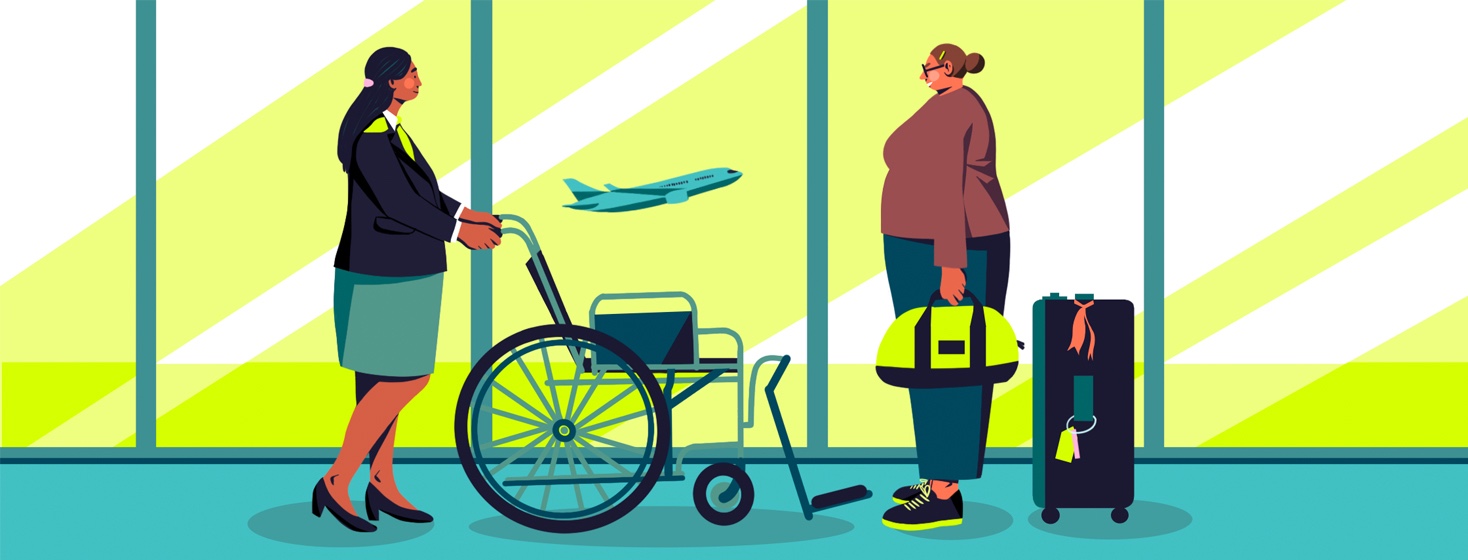Special Assistance When Traveling
“The Air Carrier Access Act (ACAA) is a law that makes it illegal for airlines to discriminate against passengers because of their disability. The Department of Transportation is responsible for enforcing the ACAA, which applies to all flights to, from, or within the United States. Airlines are also required to provide passengers with disabilities many types of assistance, including wheelchair or other guided assistance to board, deplane, or connect to another flight; seating accommodation assistance that meets passengers’ disability-related needs; and assistance with the loading and stowing of assistive devices.”1
Traveling's always been a reality for me
Traveling with a disability is hard, but traveling with an invisible disability can sometimes be harder. I tend to travel a lot because my mother was the only person in her family to immigrate from the Dominican Republic to the States. My mother leaving her family behind meant she was alone in the States until she had my sister and me. This also meant that we spent a lot of time traveling back and forth from the Dominican Republic to the States to spend time with our family since they couldn’t visit us.
Traveling can be so stressful
Traveling through an airport is a long, stressful and eventful day which requires a lot of physical and mental exertion. I remember the first time I had to use the special assistances program with the airline I was traveling with. I was so embarrassed because, at this point, I did not own a wheelchair and did not know what it felt like to be at waist level. I cried the whole ride through the airport feeling embarrassed and ashamed of using the wheelchair assistance and felt like everyone was not only looking but judging me. The more flights I took, the easier things got, and I even learned a few tricks that I would like to share:
Let the airline know
When booking a flight make sure to notify the airline that you need special assistance for your travels. In the beginning of my NMO diagnosis I did not own a wheelchair, but I did have crutches. I would use the service to get to my gate area and for help with my luggage. But as my symptoms keep developing so did my disability. Now I travel with a manual wheel chair because it's easy to fold and I can bring it all the way to the gate and airplane door.
They have a smaller wheelchair to help you get to your seat
Once you reach the airplane door, the airline will have some called an aisle seat, also sometimes called a high back or straight back, which looks like a super skinny foldable wheelchair that is specifically designed for airplanes and fits in the aisles of any plane. I sit on the aisle chair and then get brought to me seat. I’m usually one of the first to board along with my family because they have to use the isle seat and they have to put my chair away. The detachable foot rest of the wheelchair is then placed in a bin above my seat, along with any other devices that might be small enough to fit up there.
Don't forget to tag your wheel chair!
If you're bringing a wheelchair, don’t forget to get a tag for it at the counter where the gate agent sits. That way, if your wheelchair is lost or damaged, you can claim your chair and any damages that've been done to your property.
Consider how often you'll have to use the restroom
The day of travel I try not to drink too many liquids to refrain from using the bathroom. I usually tend to hydrate days prior and after arriving to my destination.
Packing wisely
Another great thing to think about it is to be a minimalist. Travel with just what you need and it will make life easier. For example, I tend to travel in jeans and a t shirt, easy slip on sneakers (TSA friendly), little jewelry, and a small backpack with essential items such as passports, gum, my disposable catheters, 1-2 pads, hand sanitizer, and off course my lipstick.
Getting through security
Going through TSA is a bit of a hassle but usually I stay seated through the process of the pat downs and wheelchair checks, though they sometimes bring a K9. I usually tip the airport employee that helps, and they're generally nice enough to stop if I want to buy something at a shop inside the airport.
Finally at my destination
After arriving to my destination I’m usually the last to get off the plane. I get seated on the aisle chair and am taken out to the plane door where my manual wheelchair awaits, never forgetting my foot rest! After that, the local airport employee usually takes me through immigration (this where I smile rolling past everyone in line) and get faster service, which includes my family. Then we proceed to the luggage area where the airport employee also helps to get my luggage, which is great. They then wheel me outside until I finally get into a car, headed for my final destination. Again, I usually tip because I think these employees go the extra mile, but then again, it’s a part of their job.
Don't be shy about asking for special services!
Now with my experience flying I don’t even have to double-think about asking for special services when I book a trip. It saves me a lot of energy and saves me from fatiguing. So the next time you travel, remember: if you have some sort of disability don’t forget to request special services. They are there for you and it’s your right! Also don’t forget to have a good time at your destination!
Life with NMO is rarely easy, but with some experience,
traveling can get easier.

Join the conversation